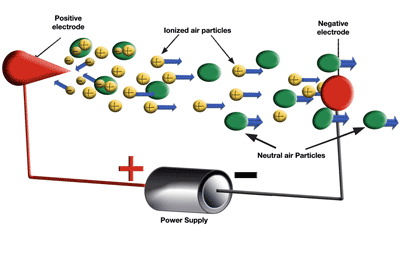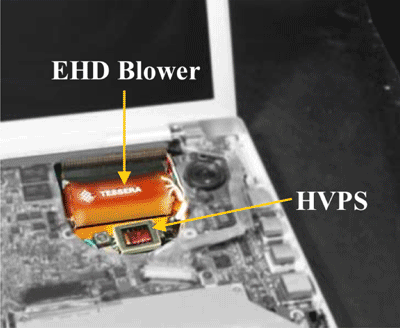Silent air-cooling technology: a solution to the cooling quandary?
Miniaturization has created a demand for a new active cooling technology to replace fans
BY KEN HONER
Tessera Technologies, San Jose, CA
http://www.tessera.com
Heat is the inevitable byproduct of electronic devices. It is also the most common cause of electronics failure. As such, electronics need to be cooled and fans are the most popular way to cool them. Fans are simple, effective and relatively inexpensive. Until recently, they were also good enough. New advances in miniaturization and steady increases in component performance have forced manufacturers to look beyond the fan.
Modern electronics not only need the kind of thermal efficiency that forced air cooling provides, but they also need to function in a smaller and thinner space than ever before. Smaller fans need to work harder and run faster to move as much air as large ones. Higher speeds mean more noise (see Fig. 1 ) and faster wear out, which makes them far from ideal for projectors, ultrathin laptops and other devices that need quiet thermal management in a compact space. As a result, designers of electronic products designers are facing what might be called the “cooling quandary.”

Fig. 1. A high-intensity electric field ionizes air molecules surrounding the corona electrode tip. As ions move from the corona electrode to the collector electrode, they collide with neutral air species, transferring charge and momentum and generating air flow.
Clearly, the industry needs a new way to cool electronics — one that is compact, quiet, efficient, and cost-effective. No such technology is yet commercially available, but one promising candidate is silent air-cooling technology (silent ACT), which creates airflow by ionizing air molecules and setting them in motion with an electric field. The ionized molecules transfer their momentum to neutral air molecules, resulting in a steady airflow that cools components with minimal noise. The noise generated by a silent ACT system can be as little as 1 dBl above the background level of a semianechoic chamber, making it essentially inaudible to the human ear in a normal environment.
The principles behind silent ACT have been known for decades, but there have recently been important strides toward turning it into a product. Engineers at Tessera Technologies have retrofitted a prototype silent ACT device into a standard laptop, proving that the technology can work side by side with existing electronic systems (see Fig. 2 ). More recent activity has been in establishing longevity and optimizing performance.

Fig. 2. Picture of silent ACT thermal system integrated into an operational laptop, showing both silent ACT blower and miniature high-voltage power supply (HVPS) built into the mechanical fan cavity.
Silent ACT has now reached a level of maturity where it makes sense to begin thinking about which kinds of devices are best suited to it, and, conversely, which can make do with currently available technology.
Passive cooling
All portable electronic cooling ultimately depends on the transfer of heat to air. This transfer can be accomplished directly at a hot component, or by conducting the heat to a distant radiating surface where it is transferred to the air.
In the simplest form of air cooling, called passive convection, heat is initially transferred to the air by conduction. The hot air then slowly rises and cooler surrounding air is drawn in to fill the void and is in turn heated. Passive cooling is well suited to certain products, especially small electronic devices with low heat output, such as MP3 players and mobile phones. Any device that can be cooled passively is not a likely candidate for silent ACT, or any other kind of active cooling for that matter.
Notebooks — silent ACT
Although passive cooling is completely silent, it cannot keep up with the thermal demands of high-performance electronics. Even if a notebook computer were made out of solid diamond, the world’s best isotropic heat conductor, it could only passively dissipate 10 to 15 W before overheating. By contrast, a typical notebook computer requires 25 to 60 W or more to be dissipated.
Notebook computers’ extremely compact form factor, significant heat output, and notoriously noisy fans make them strong candidates for silent ACT. The silent ACT unit for the prototype laptop described above was designed to fit within the same ~26-cm2 x 1-cm-tall cavity intended for the mechanical fan. The prototype used a cold cathode fluorescent lamp-type (CCFL) inverter circuit to convert the 12- Vdc voltage of the notebook battery to the kilovolt (kV) range required to operate the unit.
More recent prototypes have concentrated on optimizing airflow and reducing thickness and have shown the ability to remove equal amounts of heat as a stock cooling system, but with only half the power consumption.
The one category of notebook not suited for silent ACT is the netbook, whose extremely low price makes it a poor candidate in which to introduce advanced cooling technology.
Data centers — liquid cooling
Because data centers operate at fixed locations, with dedicated infrastructure, they are good candidates for liquid cooling. Unlike in portable applications, it is feasible to run pipes of water in data centers that quietly and efficiently transfer heat away from the servers to an external location where the heat can be dissipated through large radiators and fans. If the cooling load is manageable, and noise is not an issue, traditional high-pressure fans can be used without a liquid intermediary. In this case, silent ACT may serve to augment the cooling effectiveness of a fan, but is unlikely to completely replace it.
Traditional fan cooling
Desktop computers, projectors, and cable set-top boxes house powerful CPUs and other electronic components that demand the economy and thermal efficiency of active air-cooling. Many desktop computers provide sufficient space for multiple large fans to effectively remove up to several hundred watts of heat. This application is served reasonably well by conventional fans.
Recently, all-in-one desktop computers have been gaining market share. In this application, and as in projectors and set-top boxes, space is scarce and the thermal system is at ear level with the user, making silent ACT an attractive option in these cases.
LEDs — silent ACT
One of the most intriguing applications for silent ACT is LED lighting, the energy-efficient successor to incandescent bulbs. Incandescent light bulbs, operating at 800c (candela), dissipate most of their heat through radiation. In contrast, LEDs only reach temperatures between 80 and 120°C and do not throw off a significant amount of infrared energy. However, as LEDs heat up, they experience undesirable shifts in color and drops in luminescence (see Fig. 3 ). Because conventional light sockets were not designed to conduct appreciable heat away from the bulb, heat in retrofit LEDs must be dissipated via convection.

Fig. 3. Thermal image of a silent ACT device operating in close proximity to a uniformly heated large area plate. The silent ACT can produce a breeze focused on a small area, in this case just a few millimeters square and achieve a 25°C reduction in temperature.
Passive cooling, with large, heavy and expensive heat sinks is the most common solution for LED cooling and has the advantage of not creating any noise or vibration, which is unacceptable in many lighting applications. However, forced convection can remove far more heat in a smaller and lighter form factor than can passive convection, making silent ACT a promising choice for LED lighting applications.
Trends in miniaturization have created a demand for a new active cooling technology to replace fans in small devices with high heat output. No viable alternative is currently available to original equipment manufacturers, but silent ACT is a promising new technology that provides quiet, effective cooling in devices with small form factors. Recent steps toward productization have made it worthwhile for designers of electronics devices to consider the likely applications for silent ACT. In general, products with low heat output, such as MP3 players and mobile phones, or ample space for large fans, such as servers and desktop PCs, will not benefit from silent ACT. The most likely candidates for the technology include digital projectors, set-top boxes, standard laptops (but not netbooks), and LED lighting. ■
Advertisement
Learn more about Tessera





